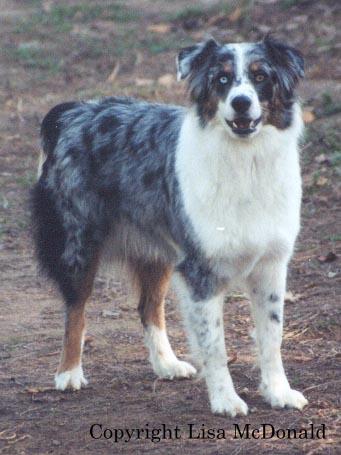
Aussie Ticking
Ticking is a common pattern in Aussies. It's the presence of flecks or spots of color in white areas. Dogs which lack ticking have clear white areas. White markings can be compared to spraying white paint over a dog, obscuring what color is underneath the paint. Tick marks are like finger smudges in that white paint revealing the color that is underneath. Ticking is inherited as a simple dominant gene. Modifiers determine how big, how many, and how round the tick marks are. Although ticking is a dominant pattern, it is not evident unless there is a white area for the trait to be expressed in. On a self colored dog or a black and tan the gene for ticking may very well be present but without white it exists unseen. Any offspring with white markings who have inherited the ticking gene will show the tick marks. Ticking can be present in both solids and merles and is independent of the merle gene. The Dalmatian is an example of a breed that is basically one big white spot covered with ticking. Ticking, when heavy, is sometimes confused with merling, but remember merle is random in distribution and ticking is confined to white areas. The tick marks themselves can be anything from small flecks (freckles) of color to larger smudges to big and round like nickles. There is considerable variation, and all are within standard.

This is Mary Fillerup's dog "Tessa". Tessa is a blue merle with tan points and a full collar. Her legs are heavily ticked with marks of varying sizes. You can see from the points where the tick marks change color where the tan points start and end on her front legs. There are also some tick marks present on her blaze, and lots in her white collar. For some reason the tick marks in her collar are much more visible seen from the side rather than viewed frontally.
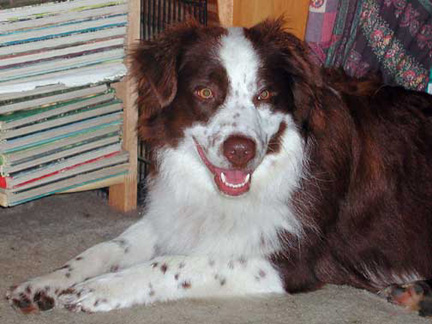
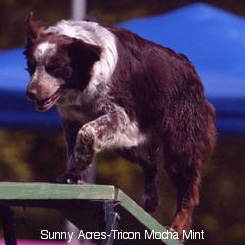
This is Sunny Acres Artful Dodger (Dodger), photo courtesy of Kate Viles, and his mom Sunny Acres - Tricorn Mocha Mint (Mocha), photo courtesy of JT Pawprints. Dodger has very pronounced tick marks around the size of dimes and they are most visible on his legs and face. His mom Mocha has even heavier ticking that is clearly visible on her legs, collar, and face. The heaviest ticking on Mocha approaches the density of ticking/roaning commonly associated with Australian cattle dogs and some Border collies, but purebred Aussies can be this heavily ticked as well. It would be easy to mistake Mocha's heavily ticked legs for red merling, but merle is laid down in random patches, and this heavy flecking is confined to the areas of white trim. Both dogs are dark red tricolors, even though their tan points are so rich they nearly match the body color.

"Alice" is a red tricolor with an interesting pattern of ticking on her muzzle. The tick marks coalesce to reveal quite a bit of her red nose bridge and tan muzzle. The white on her cranium and under her chin is not as heavily ticked as her muzzle.
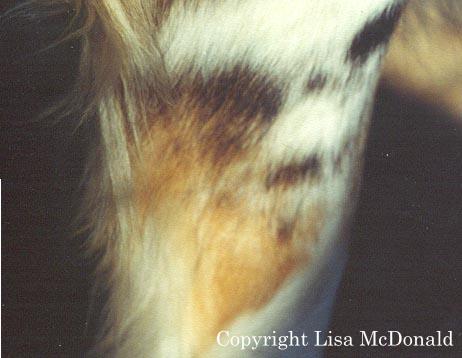
This is a closeup of the leg of Hamilton Stage Struck "Levi". He's a black tricolor with generous ticking on this portion of his leg. You can clearly see where the black of the body ends and the tan of the lower leg begins. The generous smudges in the white paint reveal where black gives way to tan underneath.

"Bobo" is a pattern white black tri Aussie (photo courtesy Amy Vanderyn). He is generously ticked and his true color is clearly visible in the tick marks. Notice how the tick marks become tan on his muzzle, throat and eye spots where his tan points should be. On the body they are black, as one would expect with a black tri. His piebald spotting pattern is nonstandard for the breed, but it does really illustrate the point that tick marks reveal whatever color is under the "white paint".
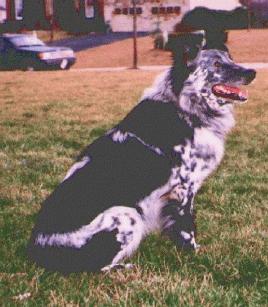
This Aussie, photo courtesy of Peggy Faith, is a piebald (pattern white) black bi with very generous ticking. He has no tan points, so all his tick marks are black. On that right front leg the tick marks coalesce into a large mass. Tick marks forming a mass is not unusual, but this is exceptional in its coverage. The pattern white is disqualifying, but fortunately for him his ears are fully pigmented and his hearing is normal. Dogs with heavy ticking are sometimes confused with merles, but merling is random in its body coverage. Notice that this dog shows flecks of color in areas normally reserved for white markings.
© 1999-2009 Lisa McDonald Comments